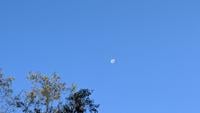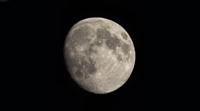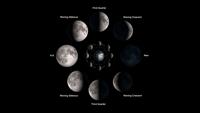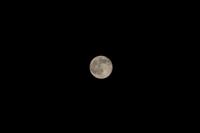The last few mornings, 69 News viewers have been seeing something bizarre: the moon shining brightly in the blue skies.
It turns out, you have an opportunity to see the moon in the sky most of the month, if the weather is good.
But why? Getting a big area of high pressure over us or near us is the first step. High pressure leads to clearing the skies, which makes it easy to spot the moon.

The moon in the sky at 7:30 A.M. on Wednesday, November 4.
With the clear skies, you have an opportunity to see the moon, if it's not full or new or close to being full or new.
You can't see a full moon during the day because full moons rise around sunset and set around sunrise. They're only out at night.

This is a picture of the last full moon on Halloween 2020.
After a full moon, the moon keeps setting later each day. On Sunday November 1, the moon set an hour after sunrise at 7:15 a.m. On Monday November 2, the moon set at 8:15 a.m.
And, the pattern continued with the moon setting an hour later each day. On Thursday, the moon set at 11:15 a.m.
With the moon setting later and later, we have a chance to see the moon during the day.
Soon, the moon will start setting a half hour later each day. This leads to the moon setting around 5:15 p.m. when we get the next new moon.

Tough to see, but this is nearly a new moon. There's not much sunlight to reflect back for us to get a good picture of the moon. You can see a sliver of the moon. Credit: NASA.
After the new moon, the moon will keep setting a half an hour later each night for a while. Then, as it approaches the full moon, it'll start setting an hour later each night. By the time we get the full moon on November 30, the set time will be back to sunrise again.
These different set times explain why you don't see a moon in the sky when you're outside some nights. You're missing it!
If you don't see it, you're outside before the moon rises or after the moon sets, provided it's not the night of the new moon.
Take Thursday for example: the moon doesn't rise until 8:30 p.m. Because sunset is at 4:53 p.m., we won't see the moon for the first few hours of the night sky.
The moon is only up all night when it's a full moon.

A picture of a close-to-full moon taken through a telescope in Northampton County by backyard astronomer Marty McGuire.
When the moon is not full, we get to see it during the day because of the way the moon moves around the Earth.
As the moon moves around the Earth, it gets into certain positions so that it's visible in our skies.
An exception is a new moon.
At that point in the moon's orbit, the moon is "trying" to block our view of the sun. In actuality, the moon just moves in front the sun.

This is a look at how the moon looks at it moves around the Earth and reflects sunlight back to Earth. Credit: NASA.
This causes the sun to shine on the back of the moon. Because the side of the moon we see lacks sunlight, there's no moonlight for us to see day or night when it's a new moon.
As the moon continues to move around the Earth, sunlight starts hitting the moon at a different angle, giving the moon a crescent-shape illumination. The farther from the sun or closer to the sun the moon gets, the bigger or smaller the crescent moon appears.

A picture of a half full moon from Northampton County. Credit: Marty McGuire.
Eventually, the moon moves to a position where it's across from sun. In other words, the Earth is directly between the moon and sun.
When this happens, the side of the moon that we see is fully illuminated by the sun. So, we see a bright full moon.

A full moon. Credit: Marty McGuire
By the way, a new moon can entirely block our view of the sun. It just doesn't happen often.
It last happened in August 2017 when some parts of the United States, like Tennessee, saw a total solar eclipse.
Check out a 360-degree video of that full eclipse shot up on a ridge in Tennessee.
The moon completely blocked the sun for a few minutes. It got so dark during that time that some stars were visible. Lights even came on in the town in the valley below!
It turns out that the stars are always up in our sky during the day, but the sun is too bright for us to see them.
Your next chance to see stars in the middle of the afternoon is April 8, 2024, our next total solar eclipse.
This time, you won't have to travel as far as Tennessee to see it. It'll be visible in parts of of northwest Pennsylvania and Ohio.

The moon blocking out the sun in 2017. Taken in Tennessee by Bill Heichel.
If you want to learn more about the moon, NASA has some interesting facts, clears up misconceptions, and has resources for children.
Thanks to NASA Ambassador Marty McGuire and West Chester University Mather Planetarium director Dr. Karen Swartz for their help with this story.
"all day" - Google News
November 05, 2020 at 06:11PM
https://ift.tt/2IbEdW9
Why can we sometimes see the moon during the day? - WFMZ Allentown
"all day" - Google News
https://ift.tt/35pEz2D
Bagikan Berita Ini














0 Response to "Why can we sometimes see the moon during the day? - WFMZ Allentown"
Post a Comment